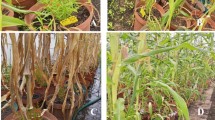Abstract
The susceptibility of maize germplasm from CIMMYT — Mexico, Malawi and Zimbabwe — to attack by the maize weevil, Sitophilus zeamais (Motsch.) was investigated under controlled temperature (28°C) and r.h. (70–75%). An index of susceptibility (I), derived from the numbers of F1 progeny and the mean development period was used as the basis for measurement of the susceptibility. The indices of susceptibility of the CIMMYT germplasm ranged from 9.25 for Rattray Arnold (I) 8149 to 14.48 for Poza Rica 7737. Of the 17 collections of Malawi local maize evaluated MLM#20 was the least susceptible (I = 10.72), while MLM#24 was the most susceptible (I = 13.25). The least susceptible of the Zimbabwean germplasm was a local collection of an indigenous maize, Variety 8 (I = 10.61), while the most susceptible was a hybrid PNR 6334 (I = 14.74). Further, the nine Mexican materials and a local hybrid SR 52 were evaluated under field conditions in small farmers’ granaries. Rattray Arnold (I) 8149 and Population 68 were the least damaged and produced the lowest numbers of weevils. Maize classified as susceptible in laboratory tests also suffered high damage levels in on-farm storage trials.
Résumé
La sensibilité des graines de maïs provenant CIMMYT — au Mexique, Malawi et Zimbabwe — à l’attaque du charançon du maïs, le Sitophilus zeamaïs (Motsch) a été étudiée sous une température de 28°C et une humidité relative de 70–75%. p ]Un indice de sensibilité (I), dérivé des nombres de la filiation F1 et la période moyenne de croissance ont servi de base de mesure de la sensibilité. Les indices de sensibilité des graines provenant sont de 9,25 pour le type Rattray Arnold (I) 8149 à 14,48 pour type Poza Rica 7737. Des 17 types du maïs local collectionnés au Malawi en vue d’être évalués, le MLM # 20 était le moins sensible (I = 10,72) tandis que le MLM # 24 était le plus sensible (I =13,25). p ]La moins sensible des graines en provenance de Zimbabwe était un type de maïs indigène, la Variété 8 (I: 10,61) tandis que le type le plus sensible était le type hybride PNR 6334 (I = 14,74). En outre au Mexique, les 9 échantillons locaux et 1 type hybride SR 52 ont été évalués dans des conditions des champs de petits grenière des agriculteurs. Le Rattray Arnold (7) 8149 et la Population 68 étaient les moins endommagés et produissaient le moins de charançons. p ]Les types de maïs prouvés sensibles lors de tests en laboratoire ont subi mêmement des dégâts très considérables dans des tests faits dans des entreposages des agriculteurs.
Similar content being viewed by others
References
Dobie P. (1974) The laboratory assessment of the inherent susceptibility of maize varieties to post-harvest infestation by Sitophilus zeamais. J. Stored Prod. Res. 10, 183–197.
Dobie P. (1977) The contribution of the tropical stored products centre to the study of insect resistance in stored maize. Trop. Stored Prod. Inf. 34, 7–21.
Dobie P. (1986) Potential uses of host plant resistance. In Proc. 4th International Working Conference on Stored-Product Protection (Edited by Donahaye E. and Navarro S.), Moor-Wallach Press.
Fortier G., Arnason J., Lambert J., McNeil J., Nozzolillo C. and Philogene B. (1982) Local and improved corns in small farm agriculture in Belize, C.A; their taxonomy, productivity and resistance to Sitophilus zeamais. Phytoprotection 63, 68–78.
Golob P. (1984) Improvements in maize storage for smallholder farmer. Trop. Stored Prod. Inf. 50, 14–19.
Rhine J. J. and Staples R. (1968) Effect of high amylose field corn on larval growth and survival of five species of stored-grain insects. J. econ. Entomol. 61, 280–282.
Rodriguez R. (1976) Determinacion de dano causado plagas de alamacen a variedades de maiz en Yucatan. Agriculture Tecnica in Mexico 3, 442–446.
Schoonhoven A. V. (1975) Selection for resistance to the maize weevil in kernels of maize. Euphytica 24, 639–644.
Singh D. N. and McCain F. S. (1963) Relationship of some nutritional properties of the corn kernel to weevil infestation. Crop Science 259–261.
Serratos A., Arnason J., Nozzolillo C., Lambert J., Philogene B., Fulcher G., Davidson K., Peacock L., Atkinson J. and Morand P. (1987) Factors contributing to resistance of exotic populations to maize weevil, Sitophilus zeamais. Phytochemistry 13, 751–762.
Author information
Authors and Affiliations
Rights and permissions
About this article
Cite this article
Giga, D.P., Mazarura, U.W. Levels of Resistance to the Maize Weevil, Sitophilus Zeamais (Motsch.) in Exotic, Local Open-Pollinated and Hybrid Maize Germplasm. Int J Trop Insect Sci 12, 159–169 (1991). https://doi.org/10.1017/S1742758400020646
Received:
Published:
Issue Date:
DOI: https://doi.org/10.1017/S1742758400020646




